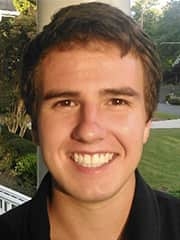Researchers from the Minds Matter Concussion Program and the Center for Injury Research and Prevention (CIRP) at Children's Hospital of Philadelphia (CHOP) recently presented some early research findings at the 9th annual Pediatric Research in Sports Medicine (PRiSM) Society Meeting. The organization focuses on interdisciplinary research, education and advancement in pediatric and adolescent sports medicine.
 Colin Huber, PhD Colin Huber, a PhD candidate in Bioengineering at University of Pennsylvania and researcher at CIRP and the Minds Matter Program at CHOP, shared results from a study about head impact exposure, led a presentation about head impact exposure, mechanisms and kinematics in female high school lacrosse athletes. Using a mouthguard sensor, the study looked at 17 players and found that the rate of head impacts was 0.32 per "athletic event," meaning a single player participating in a single game. This is similar to the rate observed in previous studies and lower than previous studies of male lacrosse and female soccer players. The researchers suggested that future studies investigate the effect of helmets on peak impact kinetics and the physiological effects of repeated head impacts in lacrosse.
Colin Huber, PhD Colin Huber, a PhD candidate in Bioengineering at University of Pennsylvania and researcher at CIRP and the Minds Matter Program at CHOP, shared results from a study about head impact exposure, led a presentation about head impact exposure, mechanisms and kinematics in female high school lacrosse athletes. Using a mouthguard sensor, the study looked at 17 players and found that the rate of head impacts was 0.32 per "athletic event," meaning a single player participating in a single game. This is similar to the rate observed in previous studies and lower than previous studies of male lacrosse and female soccer players. The researchers suggested that future studies investigate the effect of helmets on peak impact kinetics and the physiological effects of repeated head impacts in lacrosse.
 Tricia R. Roby, PhD Tricia R. Roby, PhD, a postdoctoral research fellow with CIRP and the Minds Matter Program, presented on the effect of a home exercise program on visio-vestibular function for patients who had suffered a concussion. The effects of the home exercise program were monitored in a follow-up visit within 60 days of the initial injury. The researchers found that patients who completed this home exercise program demonstrated improved aspects of visio-vestibular function. Additional research is needed to determine if this could serve as part of a battery of cost-effective concussion management tools that could help improve patient outcomes.
Tricia R. Roby, PhD Tricia R. Roby, PhD, a postdoctoral research fellow with CIRP and the Minds Matter Program, presented on the effect of a home exercise program on visio-vestibular function for patients who had suffered a concussion. The effects of the home exercise program were monitored in a follow-up visit within 60 days of the initial injury. The researchers found that patients who completed this home exercise program demonstrated improved aspects of visio-vestibular function. Additional research is needed to determine if this could serve as part of a battery of cost-effective concussion management tools that could help improve patient outcomes.
Eileen P. Storey, MD, a postdoctoral research assistant at CIRP and the Minds Matter Program, studied how concussion can affect the autonomic nervous system, which helps regulate the body's response to exercise. Storey and others focused on the relationship between exercise and monocular accommodation, or the ability of each eye to keep an object in focus as it moves from far to near. The study found that adolescents with early exercise intolerance are more likely to have abnormal accommodation after exercise but not before exercise, suggesting that aerobic exercise may serve as a stress test that can help reveal deficits after concussion. In addition, the study demonstrated that abnormal post-exercise accommodation at initial visit is associated with delayed recovery, and thus may help guide prognosis after concussion. However, since accommodation is also a vision measure, additional research is needed to further distinguish between autonomic and visual dysfunction after concussion.
Dr. Storey also presented a poster that explored the prevalence of sport specialization, or prioritization of a single sport at the exclusion of other sports, among youth athletes presenting to a tertiary care concussion program. The researchers surveyed 3,290 youth athletes between the ages of 5 and 21 years old, who answered sport specialization questions as part of a comprehensive intake questionnaire at their initial visit for concussion. The survey found that sport specialization is prevalent among youth athletes with concussion, with half of the athletes in this cohort demonstrating moderate or high specialization; it is especially prevalent among adolescents. Athletes presenting with a sports-related concussion or prior history of concussion were significantly more likely to be specialized. Additional research is needed to determine how sport specialization impacts risk for and recovery from concussion.






